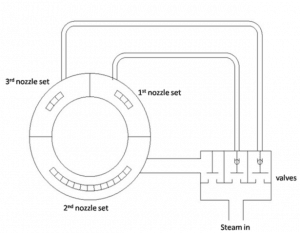The typical main turbine in nuclear power plants, in which steam expands from pressures about 6 MPa to pressures about 0.008 MPa, operates at speeds about:
- 3000 RPM for 50 Hz systems for 2-pole generator (or 1500RPM for 4-pole generator),
- 1800 RPM for 60 Hz systems for 4-pole generator (or 3600 RPM for 2-pole generator).
The variation in load (power output) during the operation of a steam turbine can significantly impact its performance and efficiency. Traditionally, nuclear power plants (NPPs) have been considered as baseload sources of electricity as they rely on technology with high fixed costs and low variable costs. However, this simple state of affairs no longer applies in all countries. The share of nuclear power in the national electricity mix of some countries has become so large that the utilities have had to implement or improve the maneuverability capabilities of their power plants to adapt the electricity supply to daily, seasonal, or other variations in power demand. For example, this is the case in France, where NPPs generate more than 75% of electricity and some nuclear reactors operate in load-following mode.
The primary objective in the steam turbine operation is to maintain a constant speed of rotation irrespective of the varying load. This can be achieved through governing of the steam turbine. The principal methods of governing which are used in steam turbines are:
-

Nozzle Governing. Source: wikipedia.org License: CC BY-SA 3.0 Throttle governing. The main parts of a simple throttle governing system are the throttle-stop valves and especially control valves between steam generators and the main turbine. The primary aim of control valves is to reduce the steam flow rate. Incidental to reducing the mass rate of flow, the steam experiences an increasing pressure drop across the control valve, which is, in fact, an isenthalpic process. Although throttling is an isenthalpic process, the enthalpy drop available for work in the turbine is reduced because this causes an increase in the vapor quality of outlet steam.
- Nozzle governing. In the nozzle control governing, the steam supply from the main valve is divided into two, three, or more lines. The flow rate of steam is regulated by the opening and shutting of sets of nozzles rather than regulating its pressure.
- Bypass governing. This is generally used for the overload valve, which passes the steam directly into the latter stages of a steam turbine. During such operation, bypass valves are opened, and live steam is introduced into the later stages of the turbine. This generates more energy to satisfy the increased load.
- Combination of 2 and 3.